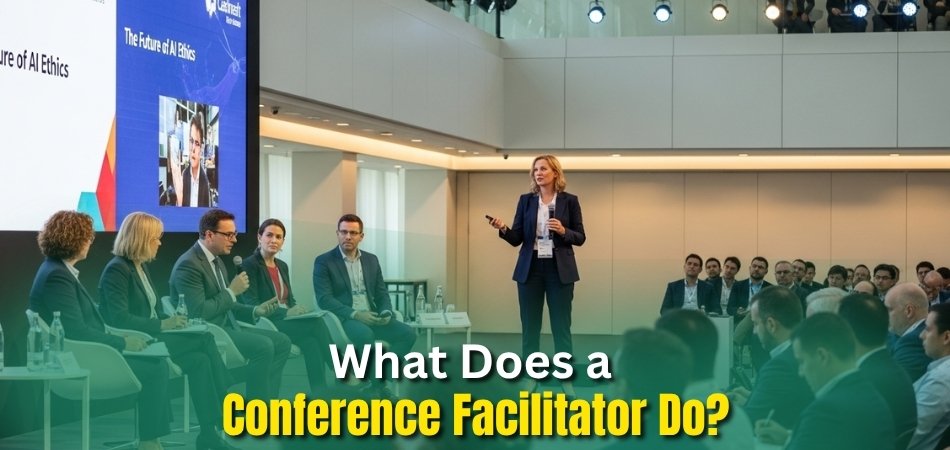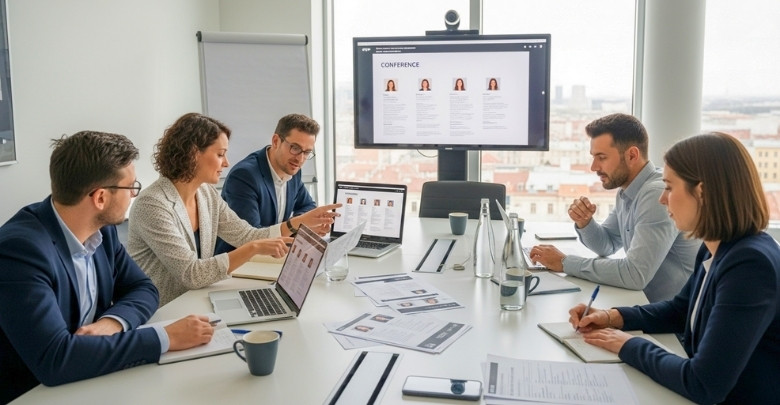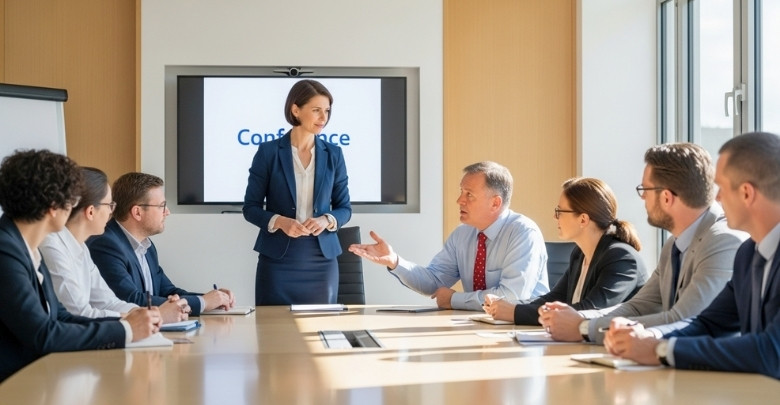Every great conference runs smoothly because someone is quietly making it happen. This person keeps sessions on schedule, helps everyone feel included, and fixes problems before they become distractions. They build an atmosphere where ideas flow easily, questions are welcome, and connections form naturally between participants.
So, what does a conference facilitator do?
A conference facilitator makes sure the event runs smoothly. They guide talks, help people join in, and keep time. They explain ideas clearly, support questions and teamwork, and help people connect. If problems happen, they solve them so everyone has a good and useful experience.
In the rest of this article, we’ll explore their responsibilities in detail and why they’re so essential to successful events.
What Does a Conference Facilitator Do?
A conference can feel exciting, but it can also get confusing without someone to guide it. People from many places come together, and without direction, discussions can lose focus. That’s where a facilitator steps in to keep everything smooth. Their job is to make sure the event feels clear, connected, and enjoyable for all.

Keeping Time
One of the most important roles of a facilitator is to keep track of time. Conferences usually have many speakers and sessions planned in advance. Without timing, things can stretch too long and affect the rest of the schedule. A good facilitator makes sure sessions start and finish when they should.
Guiding Discussions
Conferences are all about sharing ideas and learning from others. A facilitator helps guide these talks so that everyone stays focused. They make sure people don’t wander off topic and that the main points are covered. This way, discussions remain useful and meaningful.
Involving Everyone
Sometimes people feel shy to speak or unsure about joining in. A facilitator encourages everyone to share their thoughts. They might ask questions to draw people in or invite quieter voices to add their ideas. This helps make the conference feel fair and balanced.
Explaining Clearly
Not everyone may fully understand complex talks or discussions. A facilitator steps in to explain or summarize points in a simple way. This makes sure that everyone can follow along and take home the main ideas. Clear communication keeps the event enjoyable for all.
Encouraging Respect
When many people gather, differences in opinion are common. A facilitator ensures that conversations stay polite and respectful. They remind people to listen and give space for others to talk. This creates a friendly space where people feel comfortable sharing.
Helping People Connect
Conferences are also about meeting new people and building connections. Facilitators help attendees interact with each other during breaks or group sessions. By creating chances for networking, they help participants find useful contacts. This adds more value beyond the main talks.
Solving Problems
Sometimes problems happen during a conference, like technical issues or disagreements. The facilitator quickly steps in to solve them. By handling these situations calmly, they keep the event running smoothly. This way, everyone can stay focused on learning and sharing.
A conference facilitator is like the backbone of any event, making sure everything flows well from start to end. Whether it’s in Canada, the USA, or other popular hosting places like the UK, you can see how important their role is when planning upcoming conferences in Canada or anywhere else. Their job ensures people enjoy, learn, and connect without distractions.
Essential Skills Every Conference Facilitator Needs
A conference facilitator needs many different skills to manage people and events in a smooth way. These skills help them keep everyone engaged, manage challenges, and make learning enjoyable. Below are some of the most essential skills explained in detail.
Clear Communication
- A facilitator speaks in a way that makes people feel included, using examples that connect directly with them.
- They explain tough points with short sentences, so everyone can understand and remember the main details easily.
Strong Organization
- Good organization means keeping track of time, speakers, and activities without letting the flow break suddenly.
- By planning ahead, they avoid surprises and make sure every part of the conference feels well-structured.
Active Listening
- Listening carefully allows them to understand concerns from attendees and respond in ways that show respect.
- They focus on words, tone, and small signals, making people feel heard and valued during conversations.
Problem Solving
- Quick problem solvers reduce stress when issues like delays or confusion occur in the middle of sessions.
- They use practical solutions that keep participants calm and help the program continue without long interruptions.
People Skills
- Building comfort is key, so they use friendly gestures and create a space where people enjoy interacting.
- They notice when someone feels left out and gently bring them into group activities and discussions.
Time Management
- Time is important, so facilitators make sure sessions start and finish when planned to avoid confusion.
- They monitor the clock, guiding speakers and attendees to keep the event running smoothly throughout the day.
Adaptability
- Unexpected things happen, but facilitators stay flexible and find ways to adjust while keeping everyone calm.
- They change plans when needed, showing participants that challenges are normal and not a reason to worry.
Conflict Handling
- Disagreements may arise, so they step in with care and create solutions that reduce arguments effectively.
- They encourage respectful dialogue and remind people to focus on shared goals instead of differences.
How to Choose the Right Facilitator for a Conference?
Picking the right facilitator shapes your conference more than a fancy venue or flashy slides. You need someone who can guide, energize, and keep time without drama. This simple guide walks you through clear steps. Use it to choose confidently and support strong ideas, calm rooms, and smooth sessions today.
Step 1: Set Clear Goals
Begin by writing down the outcomes you want from the event. List top topics, audience needs, and success signs you can measure. Share that list with candidates and ask how they would deliver each point. Clear goals help you judge skills quickly and avoid glossy promises.
Step 2: Clarify the Role
Clarity on the role helps every later choice land well. If anyone feels unsure, share the definition of a conference facilitator and discuss how that applies here. Spell out tasks like timekeeping, guiding talks, and fixing issues on the spot. When everyone agrees on duties, interviews feel sharper and fairer.
Step 3: Match Experience
Experience matters when sessions are complex or audiences are mixed. Check past events that look like yours in size, format, and industry. Ask for short stories about tough moments and what the person did. Real examples show judgment, calm action, and smart timing.
Step 4: Review Style
Style shapes the vibe more than fancy slides or jokes. Watch a short video or attend a trial session to see them live. Notice how they invite quiet voices and handle loud ones kindly. Choose someone whose presence feels steady, warm, and focused.
Step 5: Test Communication
Communication style can make or break the room. Request a brief recap after your call and see how clearly it reads. Look for simple words, accurate notes, and next steps you can follow. Strong communicators save hours later and prevent silly confusion.
Step 6: Check References
References reveal patterns you might miss in a short call. Call two clients and ask what worked, what failed, and what changed. Press for details about timing, audience energy, and conflict moments. Consistent praise across calls often signals real, repeatable skill.
Step 7: Assess Fit
Culture fit keeps energy steady across long days. Share your audience mix, goals, and any sensitive topics up front. See how the candidate adapts plans without pushing a one-size plan. Pick the person who meets needs while respecting your voice.
Step 8: Align Budget
Budget should reflect value, not only hours on a sheet. Compare packages that include prep calls, agenda design, and recap notes. Ask how they price changes, extra sessions, or travel quirks. Choose transparent terms so money never disrupts the day.
Step 9: Decide and Prepare
Preparation turns a good choice into a great result. Lock a timeline for agendas, speaker briefs, and tech checks. Set a clear channel for updates and fast decisions during the event. With roles set, your facilitator can focus on people and results.
Common Facilitation Methods for Large Conferences
Large conferences often bring energy, excitement, and challenges that require thoughtful methods to guide participants smoothly. Facilitators use different styles to keep sessions effective, discussions lively, and participants engaged. These methods also help maintain focus while encouraging active learning and networking. Below are some widely used approaches explained simply.
Panel Discussions
Panel discussions create opportunities for multiple voices to speak on one stage with shared goals. Facilitators guide questions toward panelists, making conversations sharp, useful, and engaging for participants. Clear direction prevents wandering topics while highlighting diverse ideas from different perspectives. The style works well for expert-driven conferences with large audiences.
Breakout Sessions
Breakout sessions divide the crowd into smaller groups, allowing focused interaction and learning. Facilitators assign topics, provide guidance, and encourage participants to share meaningful insights. The smaller setting makes even quiet voices easier to hear clearly. Attendees often leave these groups with a stronger understanding and useful ideas.
Keynote Moderation
Keynote sessions often need facilitation to stay sharp, meaningful, and relevant. Facilitators keep the speaker’s flow smooth while controlling time. They may open with introductions, frame questions, or close with quick summaries. The method makes big talks more structured and easier for everyone to follow.
Interactive Q&A
Q&A sessions invite the audience to ask questions and engage directly with speakers. Facilitators collect questions, manage order, and ensure fairness in participation. This method keeps attendees alert and creates two-way conversations instead of one-sided speeches. When done well, everyone leaves with clarity and real answers.
World Café
World Café style brings small table discussions with rotating groups for lively exchanges. Facilitators set clear themes, provide guiding questions, and track timing across rounds. Attendees engage in multiple talks and share diverse insights from different participants. At the end, the main points combine into broader conclusions for the whole room.
Open Space
Open Space gives freedom to participants to create topics and lead conversations themselves. Facilitators provide the framework, explain guidelines, and monitor flow. The approach allows creativity and self-directed learning without fixed structures. It works best when audiences want active involvement and shared ownership of learning.
Networking Activities
Networking-focused facilitation uses games, icebreakers, and planned interactions to connect people. Facilitators design quick activities to reduce tension and open conversations easily. The methods create bonds that continue beyond the conference. People often leave with new contacts and stronger professional relationships.
Case Study Sessions
Case study sessions explore real examples and practical experiences for better understanding. Facilitators present structured scenarios, encourage participants to analyze details, and invite open sharing. These sessions help link theory with practice and keep attendees curious. The interactive style provides meaningful takeaways for real-world application.
How Facilitators Handle Difficult or Dominant Attendees?
Every large conference or group session brings together different personalities with unique communication styles. Some attendees might dominate talks while others disrupt the flow. A skilled facilitator handles these situations carefully, keeping the event balanced, engaging, and fair for everyone. Here’s how facilitators handle difficult or dominant attendees while keeping the session positive and productive.
Setting Ground Rules
- Clear rules at the start make attendees aware of limits, reducing interruptions and unnecessary dominant behavior.
- Participants respect boundaries when facilitators explain expectations directly, making smoother discussions possible without creating unnecessary friction.
Using Gentle Redirection
- A facilitator politely redirects conversations toward quieter participants, making the environment balanced for shared contributions.
- Interruptions lose power when facilitators steer discussions back to main themes, reducing dominance without unnecessary conflict.
Encouraging Equal Voices
- Attendees feel supported when facilitators invite quieter members to speak and share valuable contributions.
- Creating opportunities for equal talk time builds fairness, preventing stronger personalities from silencing less confident voices.
Managing Energy Levels
- Sessions stay calm when facilitators control overly energetic participants with steady pacing and polite pauses.
- Dominant voices lose strength when balanced against structured timing, giving everyone a fair opportunity to engage.
Private Conversations
- Facilitators sometimes speak privately with disruptive participants, addressing concerns without embarrassing them in public.
- Quiet chats build trust, allowing facilitators to reset behavior while keeping the overall group dynamic intact.
Offering Structured Activities
- Group tasks reduce dominance since attendees focus on completing shared activities instead of dominating discussions.
- Structured exercises create equal involvement, guiding every participant toward balanced collaboration and respectful engagement.
Staying Calm Under Pressure
- Calm facilitators set the tone, showing participants that no difficult situation can disrupt the session’s purpose.
- Maintaining composure prevents conflicts from escalating further, keeping conversations constructive and inclusive for everyone.
How to Measure Facilitation Success After a Conference?
Conferences bring together many people, ideas, and activities under one roof. Sometimes everything flows well, and sometimes small issues appear. Knowing if the event worked as planned is very important. Measuring success helps everyone understand what went right and what can be improved later. Here are some key ways to evaluate the effectiveness of facilitation after a conference.
Participant Feedback
Feedback from attendees gives the clearest picture of success. Simple surveys or open conversations reveal honest thoughts and feelings. When people share both good and bad experiences, facilitators learn valuable lessons. This helps them improve and make future conferences even better.
Session Engagement
Watching how people interact during sessions shows how well facilitation worked. Active questions, note-taking, and group talks mean participants are truly involved. If people sit quietly or look bored, improvement is needed. High engagement always signals a stronger and more effective event.
Time Management
A conference feels smoother when events start and finish on time. Facilitators play a big role in making this happen. Delays can reduce the number of sessions or break the flow of learning. Good timing makes people feel their time was valued.
Clear Communication
Easy-to-understand communication is a sign of good facilitation. When ideas are explained simply, participants remember them longer. Summarizing key points during and after discussions makes concepts stick. Clear language helps people leave with knowledge they can use later.
Conflict Handling
Sometimes disagreements or technical problems happen during conferences. Success shows when a facilitator handles issues calmly and fairly. Attendees feel safe when problems are solved quickly. Smooth handling of challenges keeps the event focused on learning instead of distractions.
Networking Opportunities
A successful conference gives people chances to connect with each other. When participants meet, talk, and exchange contacts, the event adds value. Facilitators can encourage friendly activities to help people bond. Building networks makes the conference more useful beyond just the sessions.
Professional Growth
Learning from one event helps a facilitator grow for the future. Honest reflection, training, and practice are key parts. Many start by improving skills and later consider becoming a professional conference facilitator to reach higher levels. Growth ensures each new event runs better than the last.
Frequently Asked Questions About the Responsibility of a Conference Facilitator
Conferences often feel lively and packed with ideas, but someone must keep everything organized. That’s where a facilitator steps in to guide the flow. These FAQs explain different parts of their role in easy words.
Why Is a Conference Facilitator Important?
A facilitator ensures that conferences run smoothly by managing time, keeping discussions meaningful, and helping participants feel included. Without them, sessions may lose focus, timing may slip, and attendees might struggle to gain value from the event.
How Do Facilitators Prepare Before a Conference?
They prepare by studying the agenda, knowing the speakers, and planning how to manage discussions effectively. This includes anticipating potential issues, preparing backup solutions, and ensuring sessions stay aligned with the main goals and expectations of the event.
Do Facilitators Work With Speakers?
Yes, facilitators often coordinate closely with speakers to ensure their sessions fit into the event’s schedule. They provide guidance, handle introductions, and support speakers with timing and audience questions, making the entire experience smoother for both presenters and listeners.
Can Facilitators Improve Audience Participation?
Absolutely, facilitators use strategies like open questions, small group activities, and interactive discussions to boost participation. Their role is to create a comfortable atmosphere where people feel encouraged to share thoughts, ask questions, and engage with both speakers and peers.
What Tools Do Facilitators Use?
Facilitators rely on tools like timers, microphones, presentation clickers, and sometimes digital apps for audience polling. These tools help them manage time, gather opinions, and keep sessions interactive, ensuring the event runs in an organized and engaging manner.
Do Facilitators Handle Technical Problems?
Yes, they often step in to assist when technical issues arise during presentations or sessions. While they may not fix everything themselves, they quickly coordinate with the technical team to minimize delays and keep the program moving without disruption.
How Do Facilitators Support Networking?
Facilitators create opportunities for participants to meet and interact with each other throughout the event. They encourage activities like icebreakers, group exercises, or guided discussions, which help attendees connect, share ideas, and build relationships that can last beyond the conference.
What Makes a Great Conference Facilitator?
A great facilitator is confident, organized, and approachable, with excellent communication and problem-solving skills. They know how to balance authority with friendliness, ensuring sessions run effectively while participants feel comfortable and included in every part of the conference.
Closing Remarks
Conferences feel better when someone makes sure things run smoothly. A facilitator helps people stay on time, share ideas, and solve problems. The meaning of what does a conference facilitator do is clear in the way they guide talks and support connections. Their role makes learning easier, keeps discussions friendly, and helps everyone enjoy the event.
A good facilitator adds real value by making people feel welcome and included. When events have this support, participants leave with new knowledge, useful contacts, and positive memories that last. That is why facilitators are truly the heart of every conference.








